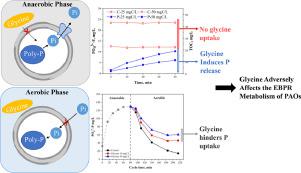Water Research ( IF 11.4 ) Pub Date : 2021-11-23 , DOI: 10.1016/j.watres.2021.117894 Yucheng Tian 1 , Hang Chen 1 , Liping Chen 1 , Xuhan Deng 1 , Zekun Hu 1 , Cenchao Wang 1 , Chaohai Wei 2 , Guanglei Qiu 3 , Stefan Wuertz 4

|
Enhanced biological phosphorus removal (EBPR) is used extensively in full-scale wastewater treatment plants for the removal of phosphorus. Despite previous evidence showing that glycine is a carbon source for a certain lineage of polyphosphate accumulating organisms (PAOs) such as Tetrasphaera, it is still unknown whether glycine can support EBPR. We observed an overall adverse effect of glycine on EBPR using activated sludge from both full-scale wastewater treatment plants and lab-scale reactors harboring distant and diverse PAOs and glycogen accumulating organisms (GAOs), including Candidatus Accumulibacter, Thiothrix, Tetrasphaera, Dechloromonas, Ca. Competibacter, and Defluviicoccus, among others. Glycine induced phosphorus (P) release under anaerobic conditions without being effectively taken up by cells. The induced P release rate correlated with glycine concentration in the range of 10 to 50 mg C/L. PAOs continued to release P in the presence of glycine under aerobic conditions without any evident P uptake. Under mixed carbon conditions, the occurrence of glycine did not seem to affect acetate uptake; however, it significantly reduced the rate of P uptake in the aerobic phase. Overall, glycine did not appear to be an effective carbon source for a majority of PAOs and GAOs in full-scale and lab-scale systems, and neither did other community members utilize glycine under anaerobic or aerobic conditions. Metatranscriptomic analysis showed the transcription of glycine cleavage T, P and H protein genes, but not of the L protein or the downstream genes in the glycine cleavage pathway, suggesting barriers to metabolizing glycine. The high transcription of a gene encoding a drug/metabolite transporter suggests a potential efflux mechanism, where glycine transported into the cells is in turn exported at the expense of ATP, resulting in P release without affecting the glycine concentration in solution. The ability of glycine to induce P release without cellular uptake suggests a way to effectively recover P from P-enriched waste sludge.
中文翻译:

甘氨酸对强化生物除磷产生不利影响
强化生物除磷(EBPR)广泛应用于大型污水处理厂中以去除磷。尽管之前的证据表明甘氨酸是某些聚磷酸盐积累生物(PAO)谱系(例如四球菌)的碳源,但甘氨酸是否可以支持 EBPR 仍不清楚。我们使用来自全规模废水处理厂和实验室规模反应器的活性污泥观察到甘氨酸对 EBPR 的总体不利影响,其中含有遥远且多样的 PAO 和糖原积累生物 (GAO),包括Candidatus Accumulibacter、 Thiothrix、Tetrasphaera、DeChlomonas、Ca 。竞争杆菌属和德氟球菌属等。甘氨酸在厌氧条件下诱导磷 (P) 释放,但未被细胞有效吸收。诱导的磷释放率与甘氨酸浓度相关,范围为 10 至 50 mg C/L。在有氧条件下,在甘氨酸存在的情况下,PAO 继续释放磷,但没有任何明显的磷吸收。在混合碳条件下,甘氨酸的出现似乎并不影响乙酸盐的吸收;然而,它显着降低了有氧阶段的磷吸收率。总体而言,在全规模和实验室规模系统中,甘氨酸似乎不是大多数 PAO 和 GAO 的有效碳源,其他群落成员也没有在厌氧或需氧条件下利用甘氨酸。宏转录组分析显示甘氨酸裂解 T、P 和 H 蛋白基因的转录,但 L 蛋白或甘氨酸裂解途径中的下游基因没有转录,这表明甘氨酸代谢存在障碍。 编码药物/代谢物转运蛋白的基因的高转录表明了潜在的外排机制,其中转运到细胞中的甘氨酸反过来以消耗 ATP 为代价输出,导致 P 释放而不影响溶液中的甘氨酸浓度。甘氨酸在不被细胞吸收的情况下诱导磷释放的能力表明了一种从富磷废污泥中有效回收磷的方法。











































 京公网安备 11010802027423号
京公网安备 11010802027423号